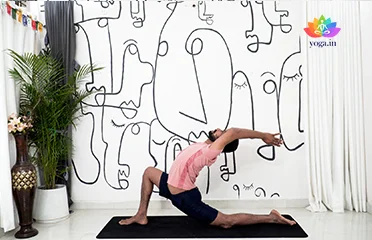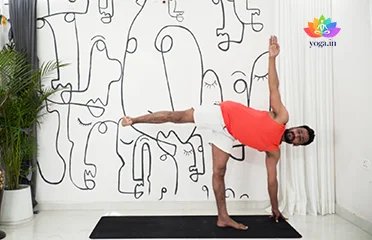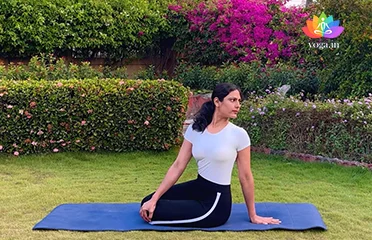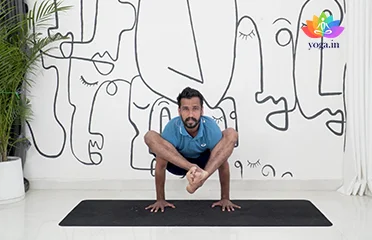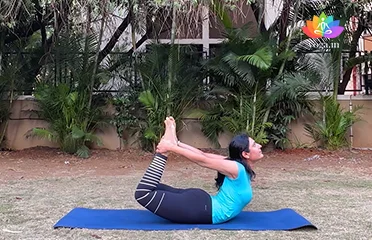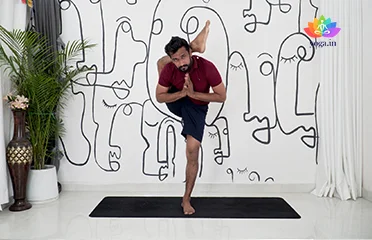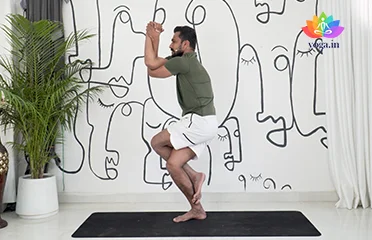Akarna Dhanurasana (Archer Pose)
अकर्णा धनुरासन / Archer Pose
The Sanskrit name is derived from Akarna (अकर्णा ) meaning towards [�K]
Anantasana (Sleeping Vishnu Pose)
अनन्तासन / Sleeping Vishnu Pose | Vishnu's Couch Pose
The Sanskrit name is derived from Ananta (अनन्त) meaning without end [�K]
Anjaneyasana (Crescent Moon Pose)
आंजनेयासन / Crescent Moon Pose
The Sanskrit name is derived from Anjane (आंजने) meaning Hanuman, [�K]
Ardha Chandrasana (Half Moon Pose)
अर्धचन्द्रासना / Half Moon Pose
The Sanskrit name is derived from Ardha (अर्ध) meaning half, Chandra [�K]
Bharadvajasana (Seated Spinal Twist)
भरद्वाजसन / Seated Spinal Twist
The Sanskrit name is derived from Bhardvaja (भरद्वाज) means bringing [�K]
Bhujangasana (Cobra Pose)
भुजंगासन / Cobra Pose
The Sanskrit name is derived from Bhujanga (भुजंगा) meaning cobra [�K]
Bhujapidasana (Shoulder-Pressing Pose)
भुजपीडासन / Shoulder-Pressing Pose
The Sanskrit name is derived from Bhuja (भुज) meaning arm/shoulder, Pida [�K]
Dhanurasana (Bow Pose)
धनुरासन / Bow Pose
The Sanskrit name is derived from Dhanur (धनुर) means bow and Asana [�K]
Durvasasana (Sage Durvasa’s Pose)
दुर्वासासना / Sage Durvasa's Pose
The Sanskrit name is derived from the word Durva (दुर्वा) which [�K]
Garudasana (Eagle Pose)
गरुडासन / Eagle Pose
The Sanskrit name is derived from Garuda (गरुडा) meaning eagle and [�K]
- 1
- 2
- 3
Understanding Sciatica and How Yoga Can Help
Sciatica isn’t just back pain – it’s a radiating pain that travels along the sciatic nerve, the longest nerve in the body. This nerve runs from your lower back, through your buttocks and leg, and down to your foot. When the sciatic nerve gets irritated or compressed, you experience the characteristic symptoms of sciatica:
- Sharp or shooting pain along the path of the nerve.
- Numbness or tingling sensations in the leg.
- Muscle weakness, particularly in the affected leg.
- Difficulty moving, making walking or standing challenging.
- Burning sensation in the leg.
Key Factors Contributing to Sciatica
Several factors can cause sciatica, including:
- Herniated disc: When the soft cushion between your vertebrae bulges or breaks, it can press on the sciatic nerve.
- Spinal stenosis: Narrowing of the spinal canal can squeeze the nerve roots that contribute to the sciatic nerve.
- Piriformis syndrome: This occurs when the piriformis muscle, located deep in your buttocks, tightens and irritates the sciatic nerve.
- Spondylolisthesis: A condition where one vertebra slips forward over another, affecting the nerve roots.
- Muscle spasms: Involuntary muscle contractions can compress the sciatic nerve.
Yoga as a Path to Relief
Yoga offers a natural and effective way to manage sciatica by addressing the root causes of the pain. Here’s how:
- Gentle stretching improves flexibility and reduces tightness in muscles that may be pinching the sciatic nerve.
- Targeted strengthening exercises help stabilize the spine and pelvis, taking pressure off the nerve.
- Relaxation techniques like deep breathing and meditation can ease muscle tension and reduce pain perception.
Complementary Dietary Support
Incorporating specific foods into your diet can further support sciatic nerve health:
- Anti-inflammatory foods: Turmeric, ginger, and berries can help reduce inflammation around the nerve.
- Omega-3 fatty acids: Fatty fish, chia seeds, and flaxseeds promote joint health and may reduce inflammation.
- Calcium-rich foods: Dairy products, leafy greens, and nuts are essential for bone strength and spinal health.
- Hydration: Drinking plenty of water keeps your spinal discs hydrated, which can improve overall comfort.
- Healthy fats: Avocados, olive oil, and nuts provide essential nutrients that support nerve function.
Important Cautions for Yoga with Sciatica
While yoga can be incredibly beneficial for sciatica, it’s crucial to approach your practice with caution:
- Avoid prolonged sitting: Minimize sitting for extended periods, as this can aggravate sciatic pain.
- Gentle movements: Focus on smooth, controlled movements during yoga, avoiding sudden jerks or forceful stretches.
- Seek guidance: Consult a healthcare professional or qualified yoga therapist before starting yoga for sciatica. They can help you create a safe and effective practice.
- Listen to your body: Pay attention to your pain levels. Modify poses as needed and avoid pushing yourself beyond your comfort zone.
- Avoid high-impact activities: Steer clear of exercises that might strain your lower back and worsen sciatica.
Who Should Avoid Yoga for Sciatica
Certain conditions may require modifications or necessitate avoiding yoga altogether:
- Recent surgery: If you’ve had recent back or hip surgery, it’s best to wait for clearance from your doctor before starting yoga.
- Acute injury: Individuals with severe sciatic pain or acute back injuries should wait for the initial inflammation to subside before attempting yoga.
- Pregnancy: Pregnant women with sciatica can still benefit from yoga, but they need to modify poses and consult with their healthcare providers.
- Chronic conditions: People with chronic health conditions should get approval from their doctor before starting yoga.
- Nerve disorders: Those with specific nerve disorders affecting the lower back and legs should consult with a healthcare professional before attempting yoga.
By combining a safe and appropriate yoga practice with dietary adjustments and a cautious approach, you can effectively manage sciatica and experience significant pain relief. Remember, consistency and listening to your body are key to reaping the benefits of yoga for sciatica.




